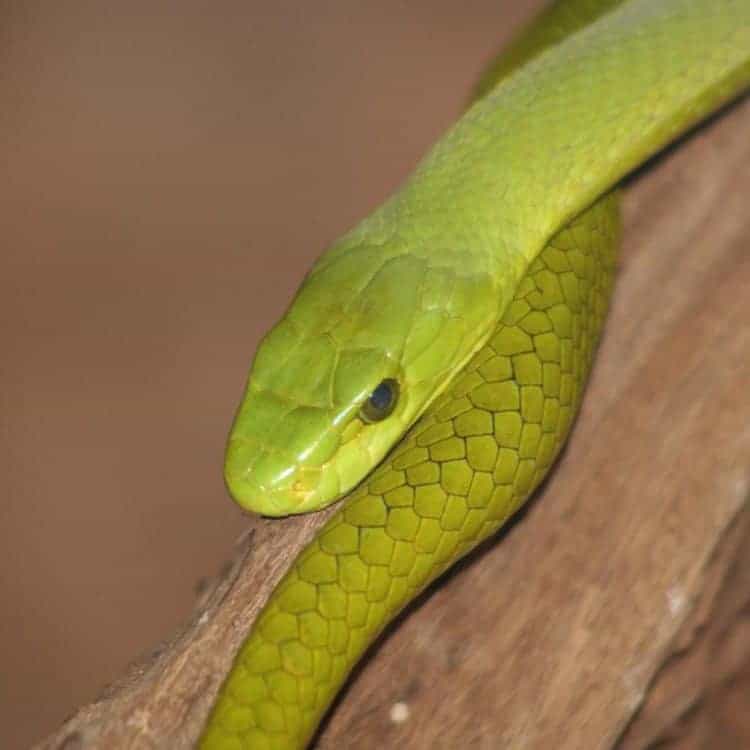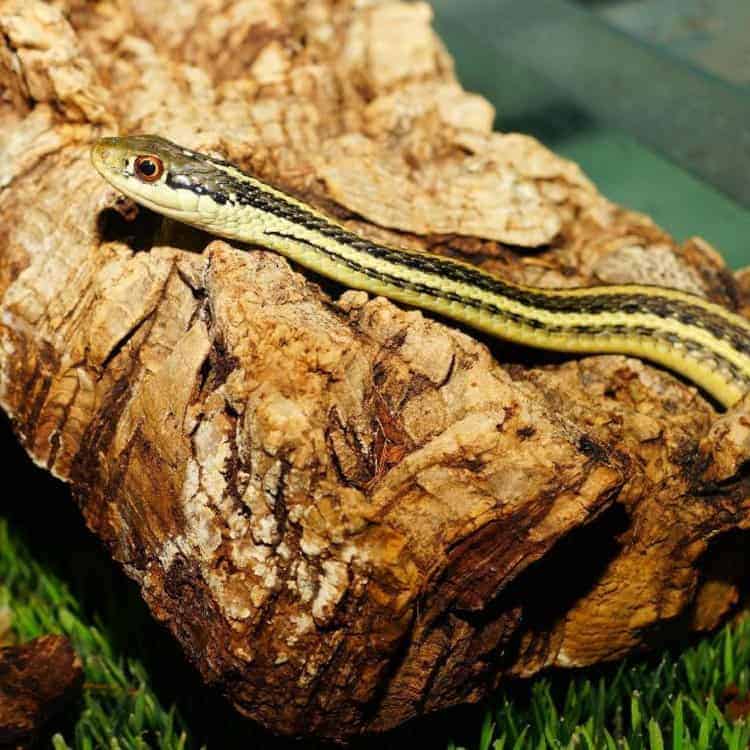So you’ve decided that you want a pet snake and you’re trying to decide what you’re looking for! A huge factor in choosing a breed of snake is picking a breed that adheres to a diet compatible with your preferences. Many pet owners cringe at the idea of feeding their slithery companion a warm-blooded vertebrate, so it’s certainly something you’ll want to consider before making a decision. Most insect-eating snakes are tiny which makes for a somewhat lower maintenance experience for owners.
While you’re in the process of picking out your pet, be sure you thoroughly research your options so you can decide from a realistic and informed perspective. Consider factors such as temperament, diets, size, maintenance needs, and safety. Weigh your options and ask other snake owners for their opinions so you will hold no regrets in such a big decision. Congrats on your decision to get your first pet snake, you’re going to love it!
Snakes that can sustain a diet of insects
The Green Snake

The Green snake (scientifically referred to as the Opheodrys) is an interesting little creature. These snakes are natives of the Nearctic region and can be found in Canada, Southern states, Southwestern states, and even in Mexico. They get their obvious name from their solid green scales that serve as an incredibly useful camouflaging tactic which helps to protect them from predators or even sneak up on their prey. They are classified as an arboreal species meaning that they live most of their lives near trees and forests but also sometimes wander into swamps and marshes. They are an incredibly slim a dainty breed of snake that rarely grows more than two feet in length.
The species can sustain a diet of just insects but this has resulted in a decrease in population. You see, when pesticides are used on insects, they poison their predators with the repellants when they get eaten. This has damaged the Opheodrys population in recent years and caused concerns since Green snakes help to control insect populations. This species is known to have a shy and slightly resentful temperament, meaning that they may present some challenges for the first-time snake owner. The creatures typically live 6 to 8 years but some well past that time, so if you choose to purchase one as a pet, recognize the long-term commitment you’re making to your pet and the responsibilities you are taking on!
The Garter Snake

Garter snakes ( scientifically referred to as the Thamnophis Sirtalis) are the perfect snake for novice owners with children who don’t want to impose any risk upon them. The snakes are generally very friendly and active during the day so they are an engaging and fun pet that you can interact with. They are also quite safe considering the fact that their bites aren’t harmful to humans aside from swelling and irritation that can occur as a result of very rare allergic reactions.
These snakes often have 3 long strips but can be found in a variety of beautiful colors and intricate patterns. They are one of the most common snakes in North America and are found all throughout woodlands, grasses, and bodies of water. They are happiest when they have lots of objects to climb and weave their way through! Generally, the snakes grow to 20 – 30 inches but some rare outliers have reached lengths of 50 inches.
Garter snakes, like Green snakes, are satisfied with eating just bugs, snails, and other invertebrates. When they feel endangered, they secrete a musky scent from a gland near the cloaca in hopes of scaring off predators. This defense mechanism is used against their variety of predators such as foxes, hawks, and birds.
These common creatures are one of the best pets to start while looking for your first pet snake! They will prove to be gentle creatures who require minimal amounts of maintenance and will reasonably fit within your lifestyle!
Snakes that can integrate insects into their diet
Snakes eat such a diverse range of creatures within the natural world ranging anywhere form tadpoles, to bugs, to mice and other mammals. Some snakes can get all of their nutritional needs on a diet of insects, while larger breeds cannot be maintain proper healthy when only eating only bugs. These snakes do best when insects are integrated into their diet along with mammals and other invertebrates to add variation in their food and broaden the range of nutrition they receive. If you look into these pets, you will discover that they can be much larger and intimidating due to the strength and mass the acquire from more a hefty diet.
The Brown Snake
The American Brown Snake (scientifically referred to as the Storeria Dekayi) is a non-venomous species found primarily within North and Central America. They are NOT to be confused with the Eastern Brown Snake (scientifically referred to as the Psuedonja Textiltis) which is actually recognized as the 2nd most venomous snake in the world! They get their obvious name from their brown skin which often has tan and red spots sprinkles around with a pale underside.
Brown Snakes have been seen in a diverse range of habitats including ponds, marshes, prairies, and woodlands but are never found in areas of high elevation. They also really like to explore rocky, dry areas even though they can thrive in moist habitats. Surprisingly, they are known as city snakes since they are one of few species which can sustain life and thrive in highly developed and urban areas.
Their diet is easy to maintain and is good for snake owners who get squeamish when feeding mammals to their snake because they eat mostly insects, fish, and snails.
These snakes are quite slim and rarely grow to a length above 15 inches, although they can be anywhere from 9 to 20 inches! They have a tendency to be shy and will always let you know if they are scared by the musky scent they have when they’re trying to scare off predators. Their predators include large snakes, hawks, and even domestic cats. Their size is pretty desirable for a pet and since they are not venomous, they may be a great option for your pet!
The Ribbon Snake

Eastern Ribbon Snakes (scientifically referred to as the Thamnophis Sauritas) are an awesome option for first-timers! This commonly known snake is very popular in the Northeastern United States and Canada with the exception of mountainous areas, as these little creatures tend to avoid high elevation. The species is considered very common and is not endangered but is protected in the state of Georgia. They are known as one of the best pet snakes because of their temper, intelligence, and low maintenance. They have 3 distinct strips, brown belly and can grow anywhere from 16-30 inches! Their patterns are often useful when they need to be camouflaged and sequentially survive. They are semi-aquatic but don’t like to go in the water, instead, they glide over it, which is a pretty fascinating thing to witness!
The temperament and personality of Eastern Ribbon Snakes can be described as mellow, intelligent, and gentle. They do not bite and they’re relatively small which makes them perfect for people with families or children. Watch out though, those slithery suckers are SMART and FAST, so they can get out of their cages if they aren’t properly secured! Their diets consist mostly of fish, insects, and amphibians and they eat more than most snakes. They also swallow their prey whole instead of squeezing or hurting them.
If you are looking for your first snake, an Eastern Ribbon Snake could be a phenomenal option for you and your family!
Conclusion
No matter which direction you choose when you’re picking out your pet snake, you will love your sly friend! Contrary to popular belief, snakes are surprisingly docile and low maintenance companions perfect for any reptile- lover looking for a pet to sssssslide their way into your heart!




